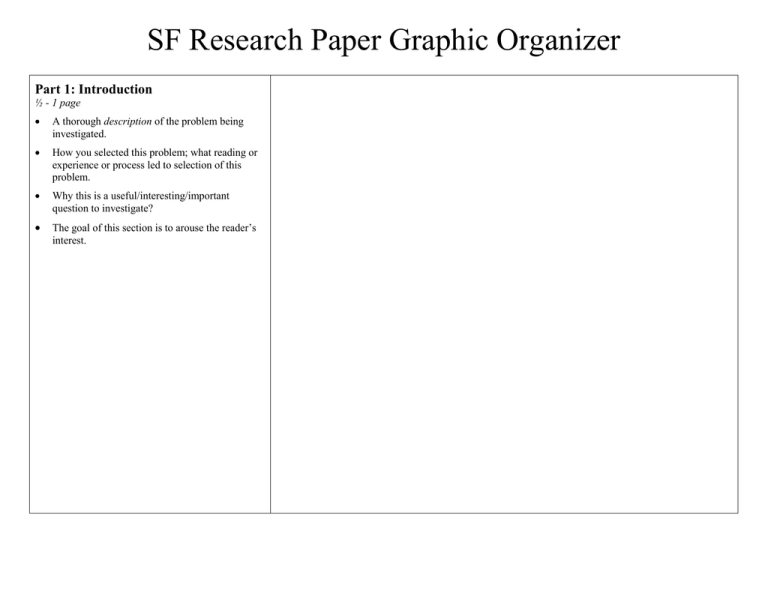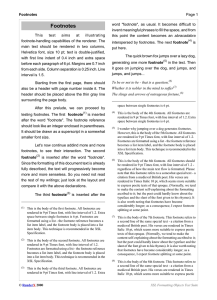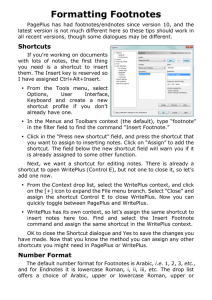SF Research Paper Graphic Organizer Part 1: Introduction
advertisement

SF Research Paper Graphic Organizer Part 1: Introduction ½ - 1 page A thorough description of the problem being investigated. How you selected this problem; what reading or experience or process led to selection of this problem. Why this is a useful/interesting/important question to investigate? The goal of this section is to arouse the reader’s interest. Part 2: Core Science Knowledge At least 2 pages, should be 25% of the paper Include core scientific information that helps you understand the science & technical information behind your topic. The info should relate directly to your particular research project, not be vaguely in the same area. Get this info from science texts, journals, books, newspapers, magazines, websites, encyclopedias, scientists and any other references you can find. This is NOT filler; only truly necessary & related information should be included. You MUST understand what you write & be able to explain it in your own words. No copying: IN YOUR OWN WORDS (teachers can always tell the difference!) Look up unfamiliar vocabulary. This section is especially important & will be used in the conclusion of your SF notebook when you try to explain the results you received. Part 3: Previous Research Previous Experiment 1: You want 3-5 previous experiments For each past experiment, include a 4-8 sentence summary indicating what was done (the problem), what they found out (results & conclusion), & who did it. Be sure to provide reference cite in your footnotes. DO NOT list or give numbered steps, but rather a written summary. Part 3: Previous Research For each past experiment, include a 4-8 sentence summary indicating what was done (the problem), what they found out (results & conclusion), & who did it. Be sure to provide reference cite in your footnotes. DO NOT list or give numbered steps, but rather a written summary. Previous Experiment 2: Part 3: Previous Research For each past experiment, include a 4-8 sentence summary indicating what was done (the problem), what they found out (results & conclusion), & who did it. Be sure to provide reference cite in your footnotes. DO NOT list or give numbered steps, but rather a written summary. Part 3: Previous Research For each past experiment, include a 4-8 sentence summary indicating what was done (the problem), what they found out (results & conclusion), & who did it. Be sure to provide reference cite in your footnotes. DO NOT list or give numbered steps, but rather a written summary. Previous Experiment 3: Previous Experiment 4: Part 4: Hypothesis ½ page An educated guess about the outcome of your experiment. Based upon the PREVIOUS RESEARCH, what results do you expect? It should also be a number or percentage. You must provide SUPPORT for your guess. Use the previous research by telling how it led to or influenced your hypothesis. HIGHLIGHT your hypothesis in some way by using capital letters or a bold font. Part 5: Materials & Procedure (shortened version/summary) ½ - ¾ page Write a summary of your experiment in formal language. DO NOT write numbered, step-by-steps procedure Describe the techniques that must be mastered in order for you to conduct this experiment, and a discussion of the resources and assistance that might be required. Please update this section if/when your procedures change. Part 6: Research Summary (conclusion) 1/2 page Summary of key points that were made in above sections. Do not use the same words. Instead, revamp your thoughts. What is the take home message? Include relevant & key research that led to the hypothesis (one of the three or four described earlier). Finish with a simple ending. Footnotes Here is how you do it: After quoting or stating a piece of information in your research paper that came directly from another work (printed on one of your note cards or from your research), you need to CITE the source. After the typing the sentence, do the following: o Select Insert (from the toolbar above), Footnote o Make sure Footnote and Auto numbering is selected. After hitting OK – it will place a mini number (starting with one) after the sentence and a matching one down below (called the footnote). 1 Make sure the footnote is after your punctuation. In the footnote, copy the source’s information straight from your MLA Bibliography (copy and paste!). Example: How do we know that the Milky Way galaxy is 12-14 billion years old? Well “The age was estimated by measuring the amount of beryllium (Be) in distant stars. The amount of beryllium increases as a star gets older.”2 1 2 This is the footnote – copy your MLA Bibliography here – like the example below “Galaxies: Milky Way.” Rader’s Cosmos4Kids.com - Andrew Radar Studios. 2006. <http://www.cosmos4kids.com/files/galaxy_milkyway.html>. 27 Sept. 2007.
![[title] Writing a Research Paper](http://s2.studylib.net/store/data/015952607_1-a24021a8b99597e61da77de3c7ee9906-300x300.png)

